高精度计算(C++版)
- 格式:ppt
- 大小:318.00 KB
- 文档页数:30
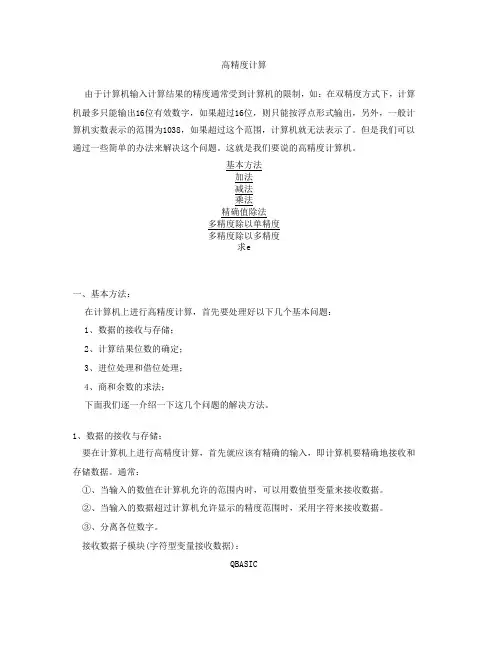
高精度计算由于计算机输入计算结果的精度通常受到计算机的限制,如:在双精度方式下,计算机最多只能输出16位有效数字,如果超过16位,则只能按浮点形式输出,另外,一般计算机实数表示的范围为1038,如果超过这个范围,计算机就无法表示了。
但是我们可以通过一些简单的办法来解决这个问题。
这就是我们要说的高精度计算机。
基本方法加法减法乘法精确值除法多精度除以单精度多精度除以多精度求e一、基本方法:在计算机上进行高精度计算,首先要处理好以下几个基本问题:1、数据的接收与存储;2、计算结果位数的确定;3、进位处理和借位处理;4、商和余数的求法;下面我们逐一介绍一下这几个问题的解决方法。
1、数据的接收与存储:要在计算机上进行高精度计算,首先就应该有精确的输入,即计算机要精确地接收和存储数据。
通常:①、当输入的数值在计算机允许的范围内时,可以用数值型变量来接收数据。
②、当输入的数据超过计算机允许显示的精度范围时,采用字符来接收数据。
③、分离各位数字。
接收数据子模块(字符型变量接收数据):QBASICPASCALINPUT a$l = LEN(a$)DIM a(l)FOR i = 1 TO la(i) = VAL(MID$(a$, i, 1))NEXTprucedure readdata(var in:array[1..100] of integer);var ch:char;i,k:integer;beginread(ch);k:=0;while ch in['0'..'9'] do begininc(k);int[k]:=ord(ch)-48;read(ch);end;end;2、计算结果位数的确定①、两数之和的位数最大为较大的数的位数加1。
②、乘积的位数最大为两个因子的位数之和。
③、阶乘与乘方的位数可以采用对数运算来确定计算结果的位数。
3、进位处理和借位处理①、加法的进位处理进行加法处理时,先设置一个加法进位标志 T,并将 T 的初值设为 0。
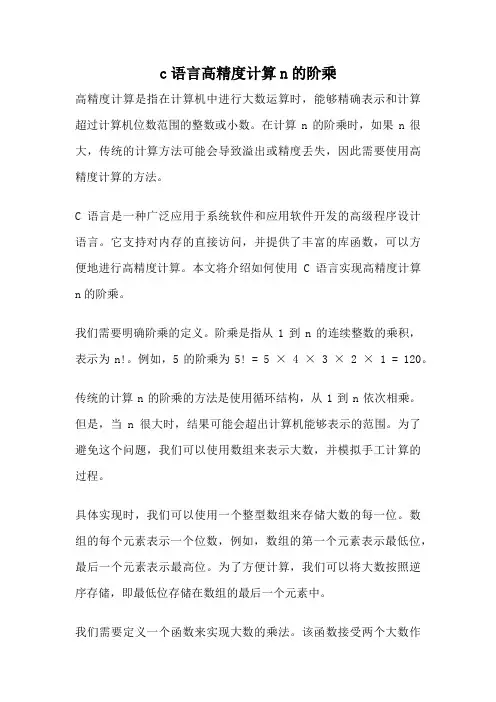
c语言高精度计算n的阶乘高精度计算是指在计算机中进行大数运算时,能够精确表示和计算超过计算机位数范围的整数或小数。
在计算n的阶乘时,如果n很大,传统的计算方法可能会导致溢出或精度丢失,因此需要使用高精度计算的方法。
C语言是一种广泛应用于系统软件和应用软件开发的高级程序设计语言。
它支持对内存的直接访问,并提供了丰富的库函数,可以方便地进行高精度计算。
本文将介绍如何使用C语言实现高精度计算n的阶乘。
我们需要明确阶乘的定义。
阶乘是指从1到n的连续整数的乘积,表示为n!。
例如,5的阶乘为5! = 5 ×4 × 3 × 2 × 1 = 120。
传统的计算n的阶乘的方法是使用循环结构,从1到n依次相乘。
但是,当n很大时,结果可能会超出计算机能够表示的范围。
为了避免这个问题,我们可以使用数组来表示大数,并模拟手工计算的过程。
具体实现时,我们可以使用一个整型数组来存储大数的每一位。
数组的每个元素表示一个位数,例如,数组的第一个元素表示最低位,最后一个元素表示最高位。
为了方便计算,我们可以将大数按照逆序存储,即最低位存储在数组的最后一个元素中。
我们需要定义一个函数来实现大数的乘法。
该函数接受两个大数作为参数,并返回它们的乘积。
具体实现时,我们可以使用两层循环遍历两个大数的每一位,并将结果保存在一个新的大数中。
在计算过程中,需要注意进位的处理。
接下来,我们可以定义一个函数来计算n的阶乘。
该函数接受一个整数n作为参数,并返回n的阶乘。
具体实现时,我们可以使用一个循环从2到n,依次计算每个数的阶乘,并将结果与之前的乘积相乘。
在计算过程中,为了避免溢出,我们可以使用前面提到的大数乘法函数。
我们可以在主函数中调用阶乘函数,并输出结果。
为了方便观察,我们可以将大数按照正常顺序输出,即从最高位到最低位。
具体实现时,可以使用一个循环从最高位到最低位遍历大数数组,并将每一位转换为字符型后输出。
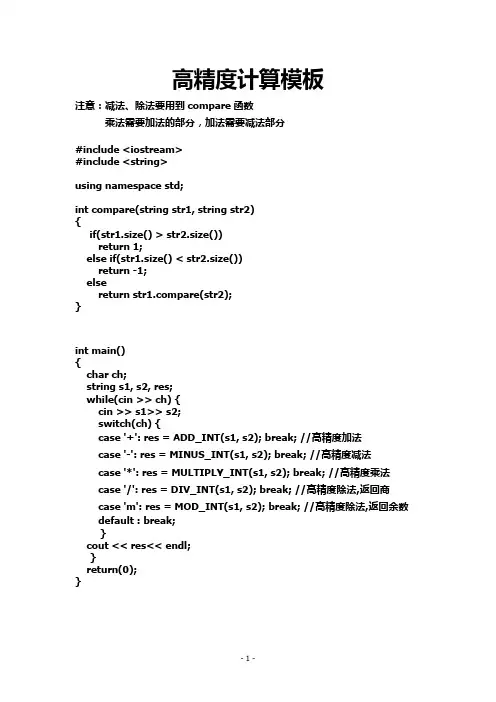
高精度计算模板注意:减法、除法要用到compare函数乘法需要加法的部分,加法需要减法部分#include <iostream>#include <string>using namespace std;int compare(string str1, string str2){if(str1.size() > str2.size())return 1;else if(str1.size() < str2.size())return -1;elsereturn pare(str2);}int main(){char ch;string s1, s2, res;while(cin >> ch) {cin >> s1>> s2;switch(ch) {case '+': res = ADD_INT(s1, s2); break; //高精度加法case '-': res = MINUS_INT(s1, s2); break; //高精度减法case '*': res = MULTIPLY_INT(s1, s2); break; //高精度乘法case '/': res = DIV_INT(s1, s2); break; //高精度除法,返回商case 'm': res = MOD_INT(s1, s2); break; //高精度除法,返回余数 default : break;}cout << res<< endl;}return(0);}string ADD_INT(string str1, string str2){string MINUS_INT(string str1, string str2);int sign = 1;string str;if(str1[0] == '-') {if(str2[0] == '-') {sign = -1;str = ADD_INT(str1.erase(0, 1), str2.erase(0, 1));}else {str = MINUS_INT(str2, str1.erase(0, 1));}}else {if(str2[0] == '-')str = MINUS_INT(str1, str2.erase(0, 1));else {string::size_type l1, l2;int i;l1 = str1.size(); l2 = str2.size();if(l1 < l2) {for(i = 1; i <= (int)(l2 - l1); i++)str1 = "0" + str1;}else {for(i = 1; i <= (int)(l1 - l2); i++)str2 = "0" + str2;}int int1 = 0, int2 = 0;for(i = str1.size() - 1; i >= 0; i--) {int1 = (int(str1[i]) - 48 + int(str2[i]) - 48 + int2) %10; int2 = (int(str1[i]) - 48 + int(str2[i]) - 48 +int2) / 10; str = char(int1 + 48) + str;}if(int2 != 0) str = char(int2 + 48) + str;}}//运算后处理符号位if((sign == -1) && (str[0] !='0'))str = "-" + str;return str;}string MINUS_INT(string str1, string str2){string MULTIPLY_INT(string str1, string str2);int i,sign = 1;string str;if(str2[0] == '-')str = ADD_INT(str1, str2.erase(0, 1));else {int res = compare(str1, str2);if(res == 0) return "0";if(res < 0) {sign = -1;string temp = str1;str1 = str2;str2 = temp;}string::size_type tempint;tempint = str1.size() - str2.size();for(int i = str2.size() - 1; i >= 0; i--) {if(str1[i + tempint] < str2[i]) {str1[i + tempint - 1] = char(int(str1[i + tempint - 1]) - 1); str = char(str1[i + tempint] - str2[i] + 58) + str;}elsestr = char(str1[i + tempint] - str2[i] + 48) + str;}for(i = tempint - 1; i >= 0; i--)str = str1[i] + str;}//去除结果中多余的前导0str.erase(0, str.find_first_not_of('0'));if(str.empty()) str = "0";if((sign == -1) && (str[0] !='0'))str = "-" + str;return str;}string MULTIPLY_INT(string str1, string str2){int sign = 1;string str;if(str1[0] == '-') {sign *= -1;str1 = str1.erase(0, 1);}if(str2[0] == '-') {sign *= -1;str2 = str2.erase(0, 1);}int i, j;string::size_type l1, l2;l1 = str1.size(); l2 = str2.size();for(i = l2 - 1; i >= 0; i --) {//实现手工乘法string tempstr;int int1 = 0, int2 = 0, int3 = int(str2[i]) - 48;if(int3 != 0) {for(j = 1; j <= (int)(l2 - 1 - i); j++)tempstr = "0" + tempstr;for(j = l1 - 1; j >= 0; j--) {int1 = (int3 * (int(str1[j]) - 48) + int2) % 10; int2 = (int3 * (int(str1[j]) - 48) + int2) / 10;tempstr = char(int1 + 48) + tempstr;}if(int2 != 0) tempstr = char(int2 + 48) + tempstr;}str = ADD_INT(str, tempstr);}//去除结果中的前导0str.erase(0, str.find_first_not_of('0'));if(str.empty()) str = "0";if((sign == -1) && (str[0] !='0'))str = "-" + str;return str;}string DIVIDE_INT(string str1, string str2, int flag){//flag = 1时,返回商; flag = 0时,返回余数string quotient, residue;int sign1 = 1, sign2 = 1, i;if(str2 == "0") { //判断除数是否为0quotient = "ERROR!";residue = "ERROR!";if(flag == 1) return quotient;else return residue;}if(str1 == "0") { //判断被除数是否为0quotient = "0";residue = "0";}if(str1[0] == '-') {str1 = str1.erase(0, 1);sign1 *= -1;sign2 = -1;}if(str2[0] == '-') {str2 = str2.erase(0, 1);sign1 *= -1;}int res = compare(str1, str2);if(res < 0) {quotient = "0";residue = str1;}else if(res == 0) {quotient = "1";residue = "0";}else {string::size_type l1, l2;l1 = str1.size(); l2 = str2.size();string tempstr;tempstr.append(str1, 0, l2 - 1);//模拟手工除法for(i = l2 - 1; i < l1; i++) {tempstr = tempstr + str1[i];for(char ch = '9'; ch >= '0'; ch --) {string str;str = str + ch;if(compare(MULTIPLY_INT(str2, str), tempstr) <= 0){quotient = quotient + ch;tempstr = MINUS_INT(tempstr, MULTIPLY_INT(str2, str));break;}}}residue = tempstr;}//去除结果中的前导0quotient.erase(0, quotient.find_first_not_of('0'));if(quotient.empty()) quotient = "0";if((sign1 == -1) && (quotient[0] !='0'))quotient = "-" + quotient;if((sign2 == -1) && (residue[0] !='0'))residue = "-" + residue;if(flag == 1) return quotient;else return residue;}//高精度除法,返回商string DIV_INT(string str1, string str2){return DIVIDE_INT(str1, str2, 1);}//高精度除法,返回余数string MOD_INT(string str1, string str2){return DIVIDE_INT(str1, str2, 0);}。
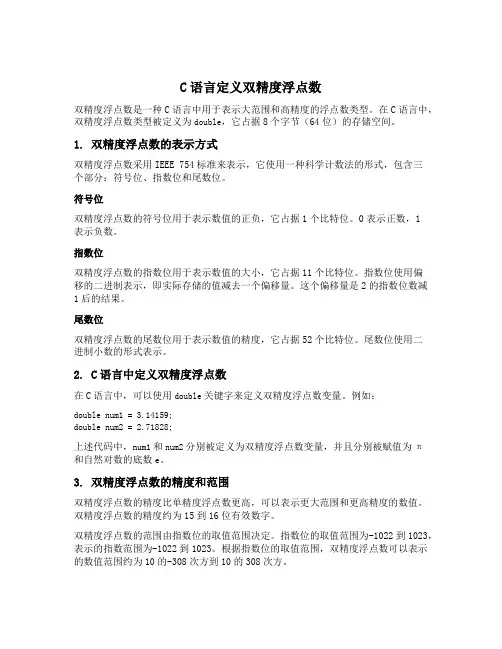
C语言定义双精度浮点数双精度浮点数是一种C语言中用于表示大范围和高精度的浮点数类型。
在C语言中,双精度浮点数类型被定义为double,它占据8个字节(64位)的存储空间。
1. 双精度浮点数的表示方式双精度浮点数采用IEEE 754标准来表示,它使用一种科学计数法的形式,包含三个部分:符号位、指数位和尾数位。
符号位双精度浮点数的符号位用于表示数值的正负,它占据1个比特位。
0表示正数,1表示负数。
指数位双精度浮点数的指数位用于表示数值的大小,它占据11个比特位。
指数位使用偏移的二进制表示,即实际存储的值减去一个偏移量。
这个偏移量是2的指数位数减1后的结果。
尾数位双精度浮点数的尾数位用于表示数值的精度,它占据52个比特位。
尾数位使用二进制小数的形式表示。
2. C语言中定义双精度浮点数在C语言中,可以使用double关键字来定义双精度浮点数变量。
例如:double num1 = 3.14159;double num2 = 2.71828;上述代码中,num1和num2分别被定义为双精度浮点数变量,并且分别被赋值为π和自然对数的底数e。
3. 双精度浮点数的精度和范围双精度浮点数的精度比单精度浮点数更高,可以表示更大范围和更高精度的数值。
双精度浮点数的精度约为15到16位有效数字。
双精度浮点数的范围由指数位的取值范围决定。
指数位的取值范围为-1022到1023,表示的指数范围为-1022到1023。
根据指数位的取值范围,双精度浮点数可以表示的数值范围约为10的-308次方到10的308次方。
4. 双精度浮点数的运算C语言提供了一系列的运算符和函数来进行双精度浮点数的运算。
常见的运算符包括加法、减法、乘法和除法。
例如:double result = num1 + num2; // 加法double result = num1 - num2; // 减法double result = num1 * num2; // 乘法double result = num1 / num2; // 除法此外,C语言还提供了一些数学函数来进行更复杂的双精度浮点数运算,如求平方根、求幂、求对数等。
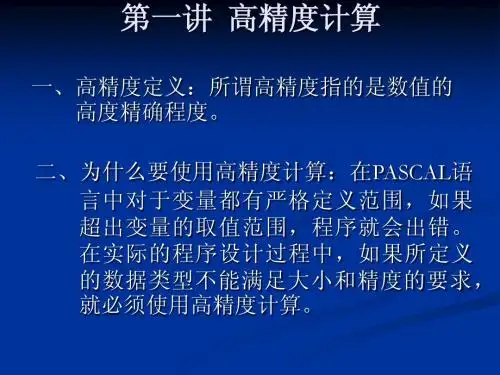

信息学奥赛NOIP系列课程(三阶段)第一阶段C++语言及数据结构与算法基础课本:1、信息学奥赛一本通+训练指导教程C++版第五版--2017年出版(两本)第1部分C++语言(50课时)适于:零基础的初中或高中的学生,当然有C语言或scratch、Python语言基础更好授课:相关内容讲授+实例+题目现堂训练(每次课2-3题,题目较大可能是1题)第1章C++语言入门(2-3课时)第2章顺序结构程序设计(6课时)第3章程序控制结构(3课时)NOIP2017复赛普及组第1题成绩https:///problem-12334.htmlNOIP2018复赛普及组第1题标题统计方法一https:///problem-12393.htmlNOIP1996普及组第1题https:///WDAJSNHC/article/details/83513564https:///yuyanggo/article/details/47311665第4章循环结构(5课时)NOIP2018复赛普及组第1题标题统计方法二https:///problem-12393.htmlNOIP2016复赛普及组第1题买铅笔https:///problem-12121.htmlNOIP2015复赛普及组第1题金币/ch0105/45/NOIP2002复赛普及组第1题级数求和/ch0105/27/NOIP2013复赛普及组第1题计数问题https:///problem-11005.html?tdsourcetag=s_pcqq_aiomsgNOIP2012复赛普及组第1题质因数分解/ch0105/43/NOIP2011复赛普及组第1题数字反转/ch0105/29/NOIP2010复赛普及组第1题数字统计https:///problem-10012.htmlNOIP1999普及组第1题Cantor表/ch0201/8760/https:///problemnew/show/P1014NOIP1997普及组第1题棋盘问题https:///problemnew/show/P1548NOIP1995普及组复赛第1题https:///secret_zz/article/details/76862335https:///WDAJSNHC/article/details/83513896NOIP1997普及组第2题数字三角形https:///ber_bai/article/details/76722379第5章数组(9-10课时)NOIP2014复赛普及组第1题珠心算测验https:///problem-12091.htmlNOIP2009复赛普及组第1题多项式输出/ch0113/39/NOIP2006复赛普及组第1题明明的随机数/ch0110/09/NOIP2005复赛普及组第1题陶陶摘苹果/ch0106/02/NOIP2004复赛普及组第1题不高兴的津津/ch0109/03/NOIP2003年普及组第1题乒乓球/ch0113/37/NOIP1998年普及组第1题三连击(枚举)https:///problemnew/show/P1008NOIP1995普及组复赛第2题方阵填数https:///WDAJSNHC/article/details/79381876NOIP1996普及组第2题格子问题https:///WDAJSNHC/article/details/79381843?utm_source=blogxgwz5NOIP2016复赛普及组第2题回文日期https:///problem-12122.htmlhttps:///problemnew/show/P2010NOIP2015普及组第2题P2670扫雷游戏/ch0108/14/https:///problemnew/show/P2670https:///problem-12105.htmlNOIP2012普及组第2题_P1076寻宝/ch0112/06/https:///problemnew/show/P1076第6章函数(5课时)NOIP2008复赛普及组第1题ISBN号码/ch0107/29/NOIP2000提高组第1题P1017进制转换https:///problemnew/show/P1017NOIP2000普及组第1题计算器的改良https:///problemnew/show/P1022https:///yuyanggo/article/details/47856785https:///u012773338/article/details/41749421NOIP2018普及组第2题龙虎斗https:///problemnew/show/P5016https:///problem-12394.html机器翻译【1.12编程基础之函数与过程抽象07】Noip2010提高组第1题/ch0112/07/Vigenère密码【1.12编程基础之函数与过程抽象08】Noip2012提高组第1题/ch0112/08/笨小猴【1.9编程基础之顺序查找06】NOIP2008提高组第1题/ch0109/06/第7章文件和结构体(5课时)NOIP2011复赛提高组第1题铺地毯/ch0109/14/NOIp2008提高组第2题火柴棒等式https:///problemnew/show/P1149https:///Mr_Doublerun/article/details/52589778第8章指针及其应用(8课时)第9章C++实用技巧与模版库(5课时)NOIP2007复赛普及组第1题奖学金/ch0110/04/NOIP2017复赛普及组第2题图书管理员(STL、排序)https:///problem-12335.htmlhttps:///problemnew/show/P3955NOIP1999普及组第2题回文数https:///problemnew/show/P1015***模拟NOIP2017年提高组第2题时间复杂度(模拟)https:///problem-12333.htmlhttps:///problemnew/show/P3952NOIP2011普及组第3题P1309瑞士轮(模拟、快拍、归并排序)/ch0401/4363/https:///problemnew/show/P1309NOIP2018复赛普及组第3题摆渡车(模拟)https:///problem-12395.htmlhttps:///problemnew/show/P5017NOIP2016普及组第3题海港(port)--枚举https:///problemnew/show/P2058NOIP2006年提高组第3题P1065作业调度方案(模拟)https:///problemnew/show/P1065NOIP2013提高组第4题P1969积木大赛(模拟贪心)https:///problem-12071.htmlhttps:///problemnew/show/P1969NOIP2014提高组第4题P2038无线网络发射器选址(模拟)https:///problemnew/show/P2038第2部分NOIP基础算法(39课时)第1章高精度计算(2-3课时)【例1.6】回文数(Noip1999):8088/problem_show.php?pid=1309NOIP2003普及组第4题P1045麦森数(分治、高精度运算)https:///problemnew/show/P1045NOIP2005普及组第4题P1050循环(高精度运算、数论、快速幂) https:///problemnew/show/P1050第2章数据排序(3课时)NOIP2014复赛普及组第1题珠心算测验https:///problem-12091.html第3章递推算法(2-3课时)1314:【例3.6】过河卒(Noip2002):8088/problem_show.php?pid=1314NOIP2011普及组第4题P1310表达式的值(栈、表达式计算、递推) https:///problemnew/show/P1310NOIP2011提高组第6题P1315观光公交(递推分析、贪心)https:///problemnew/show/P1315第4章递归算法(2-3课时)【例4.6】数的计数(Noip2001普及组第1题):8088/problem_show.php?pid=1316第5章搜索与回溯算法(2-3课时)NOIP2015day1T3_斗地主P2668斗地主https:///problemnew/show/P2668NOIP2017年普及组第3题棋盘https:///problemnew/show/P3956https:///problem-12336.htmlNOIP2015年提高组第2题P2661信息传递(Tarjen bfs/dfs(图论))https:///problem-12107.htmlhttps:///problemnew/show/P2661NOIP2016年提高组第2题天天爱跑步(Lca/dfs(图论)树结构最近公共祖先)https:///problem-12208.htmlhttps:///problemnew/show/P1600NOIP2000普及组第4题P1019单词接龙(深搜)https:///problemnew/show/P1019NOIP2000年提高组第3题单词接龙(DFS,字符串,模拟)https:///problemnew/show/P1019NOIP2014普及组第4题P2258子矩阵(搜索或dp)https:///problemnew/show/P2258NOIP2018年提高组第3题P5021赛道修建(搜索深度优先搜索)https:///problem-12392.htmlhttps:///problemnew/show/P5021第6章贪心算法(3课时)删数问题(NOIP1994)P1106删数问题https:///problemnew/show/P1106:8088/problem_show.php?pid=1321NOIP2010复赛普及组第2题接水问题/ch0109/15/NOIP1999年提高组第1题导弹拦截https:///problemnew/show/P1020https:///huashanqingzhu/p/6728652.html https:///qq_33927580/article/details/51853345 https:///Darost/article/details/52086240https:///yuyanggo/article/details/48739029NOIP2002提高组第1题均分纸牌P1031均分纸牌https:///problemnew/show/P1031NOIP2007普及组第2题_P1094纪念品分组https:///problem-12007.htmlhttps:///problemnew/show/P1094NOIP2008普及组第2题_P1056排座椅https:///problem-12008.htmlhttps:///problemnew/show/P1056NOIP2012年提高组第2题国王游戏(贪心、排序后列出)https:///problemnew/show/P1080NOIP2013年提高组第2题P1966火柴排队(逆序对、贪心、排序) https:///problem-12083.htmlhttps:///problemnew/show/P1966NOIP2010普及组第4题P1199三国游戏(贪心)https:///problemnew/show/P1199第7章分治算法(3课时)NOIP2001提高组第1题P1024一元三次方程求解/ch0204/7891/https:///problemnew/show/P1024NOIP2011年提高组第2题P1311选择客栈(二分查找)https:///problemnew/show/P1311NOIP2003普及组第4题P1045麦森数(分治、高精度运算)https:///problemnew/show/P1045第8章广度优先搜索算法(2-3课时)NOIP2002年提高组第2题P1032字串变换(BFS,字符串)https:///problemnew/show/P1032NOIP2013提高组第6题P1979华容道(广搜\最短路:图论)https:///problem-12212.htmlhttps:///problemnew/show/P1979第9章动态规划(15课时)第一节动态规划的基本模型1260:【例9.4】拦截导弹(NOIP1999):8088/problem_show.php?pid=1260NOIP2013普及组第3题P1982小朋友的数字https:///problemnew/show/P1982NOIP2003复赛普及组第2题_P1043数字游戏数字游戏(Game.cpp)https:///problemnew/show/P1043NOIP2006年提高组第2题P1064金明的预算方案(资源分配DP,构造) https:///problemnew/show/P1064NOIP2013普及组第3题P1982小朋友的数字(动态规划、子段和)https:///problemnew/show/P1982NOIP2007普及组第3题P1095守望者的逃离(动态规划或枚举)https:///problemnew/show/P1095NOIP2009普及组第4题P1070道路游戏(动态规划)https:///problemnew/show/P1070NOIP2004年提高组第3题P1091合唱队形(子序列DP)https:///problemnew/show/P1091第二节背包问题NOIP2018提高组第2题货币系统https:///problem-12391.htmlNOIP2006普及组第2题_P1060开心的金明题解https:///problemnew/show/P1060NOIP2005普及组第3题P1048采药(0/1背包)/ch0206/1775/https:///problem-12062.htmlhttps:///problemnew/show/P1048NOIP2001普及组第4题P1049装箱问题(0/1背包或枚举)https:///problemnew/show/P1049NOIP2014年提高组第3题P1941飞扬的小鸟(背包DP)https:///problem-12087.htmlhttps:///problemnew/show/P1941第三节动态规划经典题NOIP2000年提高组第2题P1018乘积最大(资源分配DP)https:///problemnew/show/P1018NOIP2000普及组第3题P1018乘积最大(划分动态规划)https:///problemnew/show/P1018NOIP2001年提高组第2题P1025数的划分(资源分配DP,多维状态DP)/ch0206/8787/https:///problemnew/show/P1025NOIP2001年提高组第3题统计单词个数(资源分配DP,字符串) https:///problemnew/show/P1026NOIP2005年提高组第2题P1052过河(子序列DP,贪心优化)https:///problemnew/show/P1052NOIP2010年提高组第2题P1541乌龟棋(动态规划优化)https:///problemnew/show/P1541NOIP2014年提高组第2题P1351联合权值(动态规划搜索图结构树形DP图的遍历遍历(图论),二次展开式)https:///problem-12086.htmlhttps:///problem-12210.htmlhttps:///problemnew/show/P1351NOIP2008普及组第3题P1057传球游戏(动态规划)https:///problemnew/show/P1057NOIP2012普及组第3题摆花(动态规划)https:///problem-12366.htmlhttps:///problemnew/show/P1077NOIP2002普及组第4题P1002过河卒(棋盘动态规划)https:///problemnew/show/P1002NOIP2008年提高组第3题P1006传纸条(多维状态DP动态规划图结构最短路网络流)https:///problem-12110.htmlhttps:///problemnew/show/P1006NOIP2000提高组第4题方格取数(多维状态DP)/ch0206/8786/https:///problem-12186.htmlhttps:///problemnew/show/P1004NOIP2002提高组第4题P1034矩形覆盖(动态规划/贪心/搜索剪枝) /ch0405/1793/https:///problemnew/show/P1034第3部分NOIP数据结构(19课时)第1章栈(3课时)NOIP2011普及组第4题P1310表达式的值(栈、表达式计算、递推) https:///problemnew/show/P1310第2章队列(3-5课时)NOIP2016普及组第3题海港(port)https:///problemnew/show/P2058第3章树(3课时)第一节树的概念第二节二叉树第三节堆及其应用NOIP2015普及组第4题P2672推销员(枚举、堆)https:///problemnew/show/P2672NOIP2001普及组第3题P1030求先序排列(树的遍历)https:///problemnew/show/P1030NOIP2004普及组第3题P1087FBI树(二叉树的遍历)https:///problemnew/show/P1087第4章图论算法(8课时)第一节基本概念第二节图的遍历第三节最短路径算法NOIP2002普及组第3题P1037产生数(最短路、高精度)https:///problemnew/show/P1037NOIP2012普及组第4题P1078文化之旅(搜索、最短路(图论)、动规) https:///problemnew/show/P1078NOIP2009年提高组第3题P1073最优贸易(最短路:图论)https:///problemnew/show/P1073NOIP2001提高组第4题P1027Car的旅行路线(最短路,实数处理)https:///problemnew/show/P1027NOIP2007提高组第4题P1099树网的核(最短路,树的直径)https:///problemnew/show/P1099第四节图的连通性问题第五节并查集NOIP2010年提高组第3题P1525关押罪犯(二分答案或并查集)https:///problemnew/show/P1525NOIP2017提高组第4题P3958奶酪(数据结构树结构并查集)https:///problem-12205.htmlhttps:///problemnew/show/P3958第六节最小生成树第七节拓朴排序与关键路径NOIP2013普及组第4题P1983车站分级(图论、拓扑排序) https:///problemnew/show/P19831390:食物链【NOI2001】:8088/problem_show.php?pid=1390NOIP2004年提高组第2题P1090合并果子(最优哈夫曼树,排序,贪心)https:///problemnew/show/P1090NOIP2013年提高组第3题P1967货车运输(最大生成树,最近公共祖先)https:///problemnew/show/P1967NOIP2018提高组第4题P5022旅行(搜索图结构)https:///problem-12397.htmlhttps:///problemnew/show/P5022NOIP2018提高组第6题P5024保卫王国(图结构)https:///problem-12399.htmlhttps:///problemnew/show/P50242、啊哈!算法--2014-06(35-50小时)第二阶段算法与数据结构提高1、《信息学奥赛一本通·提高篇》(80-100课时,不一定一次都讲完)第一部分基础算法第1章贪心算法NOIP2002提高组第1题P1031均分纸牌(贪心,模拟)https:///problemnew/show/P1031NOIP2010普及组第3题P1158导弹拦截(排序+枚举,贪心)https:///problemnew/show/P1158NOIP2012提高组第6题P1084疫情控制(二分答案,贪心,倍增)https:///problemnew/show/P1084第2章二分与三分NOIP2010年提高组第3题P1525关押罪犯(二分答案或并查集)https:///problemnew/show/P1525NOIP2008提高组第4题P1155双栈排序(枚举,贪心/二分图)https:///problemnew/show/P1155NOIP2015提高组第4题P2678跳石头(二分查找、二分答案)https:///problem-12198.htmlhttps:///problemnew/show/P2678第3章深搜的剪枝技巧NOIP2018普及组第4题对称二叉树(搜索树结构深度优先搜索)https:///problem-12396.htmlhttps:///problemnew/show/P5018NOIP2011年提高组第3题P1312Mayan游戏(深搜、剪支)https:///problemnew/show/P1312NOIP2015年提高组第3题P2668斗地主(分情况,剪枝)https:///problemnew/show/P2668NOIP2003提高组第4题P1041传染病控制(随机贪心/搜索剪枝)https:///problemnew/show/P1041NOIP2004提高组第4题P1092虫食算(搜索搜索与剪枝)https:///problem-12414.htmlhttps:///problemnew/show/P1092第4章广搜的优化技巧NOIP2017年普及组第3题棋盘(搜索搜索与剪枝广度优先搜索)https:///problemnew/show/P3956https:///problem-12336.htmlNOIP2009提高组第4题P1074靶形数独(搜索优化)https:///problemnew/show/P1074NOIP2010提高组第4题P1514引入水域(广搜+动态规划,判断有解和无解)https:///problemnew/show/P1514第二部分字符串算法第1章哈希表第2章KMP算法第3章Trie字典树第4章AC自动机NOIP2005提高组第4题P1054等价表达式(字符串,抽样检测,表达式) /practice/1686/https:///problemnew/show/P1054NOIP2008普及组第4题P1058立体图(字符输出)https:///problemnew/show/P1058NOIP2006普及组第3题P1061Jam的计数法(数学、字符串)https:///problemnew/show/P1061NOIP2007年提高组第2题字符串的展开(字符串模拟)https:///problem-11016.htmlhttps:///problemnew/show/P1098NOIP2003年提高组第2题P1039侦探推理(枚举,模拟,字符串)https:///problemnew/show/P1039NOIP2011普及组第2题_P1308统计单词数/ch0112/05/https:///problemnew/show/P1308第三部分图论第1章最小生成树第2章最短路径NOIP2016年提高组第3题P1850换教室(最短路/Dp)https:///problemnew/show/P1850NOIP2017年提高组第3题P3953逛公园(搜索图结构记忆化搜索最短路)https:///problem-12337.htmlhttps:///problemnew/show/P3953NOIP2014提高组第5题P1351联合权值(遍历,二次展开式)https:///problem-12086.htmlhttps:///problemnew/show/P1351第3章SPFA算法的优化第4章差分约束系统第5章强连通分量第6章割点和桥第7章欧拉回路第四部分数据结构第1章树状数组第2章RMQ问题第3章线段树NOIP2012提高组第5题P1083借教室(枚举、线段树、树状数组、二分) https:///problem-12069.htmlhttps:///problemnew/show/P1083NOIP2017提高组第6题P3960列队(数据结构平衡树线段树)https:///problem-12339.htmlhttps:///problemnew/show/P3960第4章倍增求LCANOIP2015提高组第6题P2680运输计划(Lca或线段树)https:///problem-12213.htmlhttps:///problemnew/show/P2680第5章树链剖分第6章平衡树Treap第五部分动态规划第1章区间类型动态规划NOIP2007年提高组第3题P1005矩阵取数游戏(区间DP,高精度)https:///problemnew/show/P1005第2章树型动态规划NOIP2003年提高组第3题P1040加分二叉树(树,区间DP)https:///problemnew/show/P1040第3章数位动态规划第4章状态压缩类动态规划NOIP2017提高组第5题P3959宝藏(动态规划搜索贪心状态压缩DP枚举)https:///problem-12340.htmlhttps:///problemnew/show/P3959NOIP2016提高组第6题愤怒的小鸟(状态压缩动态规划)https:///problemnew/show/P2831第5章单调队列优化动态规划NOIP2016提高组第5题蚯蚓(单调队列)https:///Mrsrz/p/7517155.htmlhttps:///m0_38083668/article/details/82557281NOIP2017普及组第4题P3957跳房子(数据结构动态规划单调队列队列)https:///problem-12338.htmlhttps:///problemnew/show/P3957第6章利用斜率优化动态规划NOIP2012年提高组第3题P1081开车旅行(离线深搜,动态规划、倍增)https:///problemnew/show/P1081NOIP2015提高组第5题P2679子串(Dp+滚动数组)https:///problemnew/show/P2679第六部分数学基础第1章快速幂第2章素数第3章约数第4章同余问题第5章矩阵乘法第6章组合数学NOIP2009年提高组第2题P1072Hankson的趣味题(初等数论,质因数,组合数学)https:///problemnew/show/P1072NOIP2006提高组第4题P10662^k进制数(动态规划/组合数学,高精度) https:///problemnew/show/P1066NOIP2011提高组第4题P1313计算系数(组合、二项式系数)/practice/4036/https:///problemnew/show/P1313NOIP2016提高组第4题P2822组合数问题(杨辉三角)https:///problemnew/show/P2822第7章博弈论NOIP2004普及组第4题P1088火星人(数学:排列、stl)https:///problemnew/show/P1088NOIP2009普及组第3题P1069细胞分裂(数论)https:///problemnew/show/P1069NOIP2000提高组第1题P1017进制转换(初等代数,找规律)https:///problemnew/show/P1017NOIP2001提高组第1题P1024一元三次方程求解(数学,枚举,实数处理) /ch0204/7891/https:///problemnew/show/P1024NOIP2003普及组第3题P1044栈(数学:卡特兰数)https:///problemnew/show/P1044NOIP2018年提高组第2题货币系统(数论)https:///problem-12391.htmlhttps:///problemnew/show/P5020NOIP2014年普及组复赛第3题螺旋矩阵(数学分析)https:///problem-12341.htmlhttps:///problemnew/show/P2239NOIP2015年普及组第3题求和(数学:数列)https:///problemnew/show/P2671NOIP2004普及组第4题P1088火星人(数学:排列、stl)https:///problemnew/show/P1088NOIP2005普及组第4题P1050循环(高精度运算、数论、快速幂) https:///problemnew/show/P1050NOIP2006普及组第4题P1062数列(数学:进制转换)https:///problemnew/show/P1062NOIP2007普及组第4题P1096$Hanoi$双塔问题(数学、高精度) https:///problemnew/show/P1096NOIP2016普及组第4题P2119魔法阵(数学分析、枚举)https:///problemnew/show/P2119NOIP2002年提高组第3题P1033自由落体(数学,物理,模拟,实数处理) https:///problemnew/show/P1033NOIP2005年提高组第3题P1053篝火晚会(置换群,贪心)https:///problemnew/show/P1053NOIP2012提高组第4题P1082同余方程(数论、递归,扩展欧几里得)https:///problemnew/show/P1082NOIP2011提高组第5题P1314聪明的质监员(部分和优化)/practice/4037/https:///problemnew/show/P1314NOIP2013提高组第5题P1970花匠(序列)https:///problem-12072.htmlhttps:///problemnew/show/P1970NOIP2018提高组第5题P5023填数游戏(DP)https:///problem-12398.htmlhttps:///problemnew/show/P50232、NOIP历年真题讲解(30-50小时)---包括初赛和复赛3、《骗分导论》(推荐指数:5颗星)--电子书(可以作为学习的参考资料)第三阶段算法与数据结构高级专题(选择性学习)1、信息学奥赛之数学专题2、高级数据结构(C++版)3、动态规划专题注:上面的内容也可能要交叉的进行讲解在线题库:1、OpenJudge在线题库/2、信息学奥赛一本通在线评测系统:8088/3、洛谷https:///4、啊哈编程/tiku/5、《信息学奥赛一本通(提高篇)》在线评测OJhttps://loj.ac/注:本系列课程将根据行业发展状况,及时优化调整课程内容,具体课程设置以实际为准。
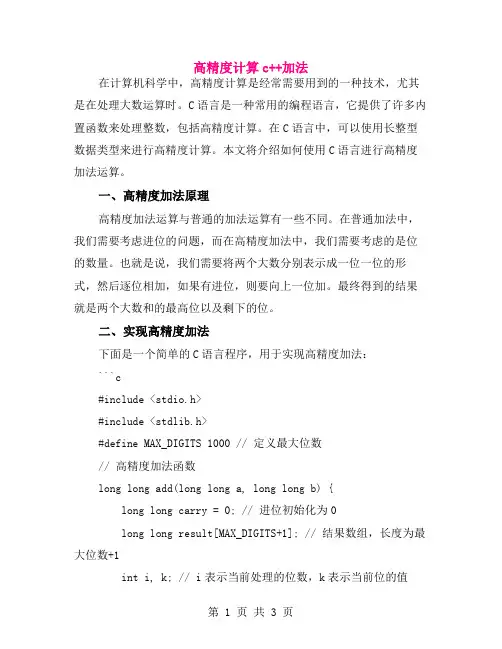
高精度计算c++加法在计算机科学中,高精度计算是经常需要用到的一种技术,尤其是在处理大数运算时。
C语言是一种常用的编程语言,它提供了许多内置函数来处理整数,包括高精度计算。
在C语言中,可以使用长整型数据类型来进行高精度计算。
本文将介绍如何使用C语言进行高精度加法运算。
一、高精度加法原理高精度加法运算与普通的加法运算有一些不同。
在普通加法中,我们需要考虑进位的问题,而在高精度加法中,我们需要考虑的是位的数量。
也就是说,我们需要将两个大数分别表示成一位一位的形式,然后逐位相加,如果有进位,则要向上一位加。
最终得到的结果就是两个大数和的最高位以及剩下的位。
二、实现高精度加法下面是一个简单的C语言程序,用于实现高精度加法:```c#include <stdio.h>#include <stdlib.h>#define MAX_DIGITS 1000 // 定义最大位数// 高精度加法函数long long add(long long a, long long b) {long long carry = 0; // 进位初始化为0long long result[MAX_DIGITS+1]; // 结果数组,长度为最大位数+1int i, k; // i表示当前处理的位数,k表示当前位的值for (i = 0; i < MAX_DIGITS; i++) { // 处理每一位k = (int)a % 10 + (int)b % 10; // 当前位的值result[i] = k + carry; // 加上进位carry = result[i] / 10; // 计算进位result[i+1] += carry * 10; // 将进位写入下一个位置}if (carry > 0) { // 如果有进位result[MAX_DIGITS] += carry; // 将最高位的进位写入结果数组的最后一位}// 将结果数组逆序输出即可得到结果for (i = MAX_DIGITS-1; i >= 0; i--) {printf("%lld ", result[i]);}printf("\n");return result[0]; // 返回结果数组的第一个值}int main() {long long a, b, result;printf("Enter two large numbers: \n");scanf("%lld %lld", &a, &b); // 读入两个大数result = add(a, b); // 对两个数进行高精度加法运算printf("Result: %lld\n", result); // 输出结果return 0;}```这个程序中,我们首先定义了一个常量MAX_DIGITS来表示最大位数。

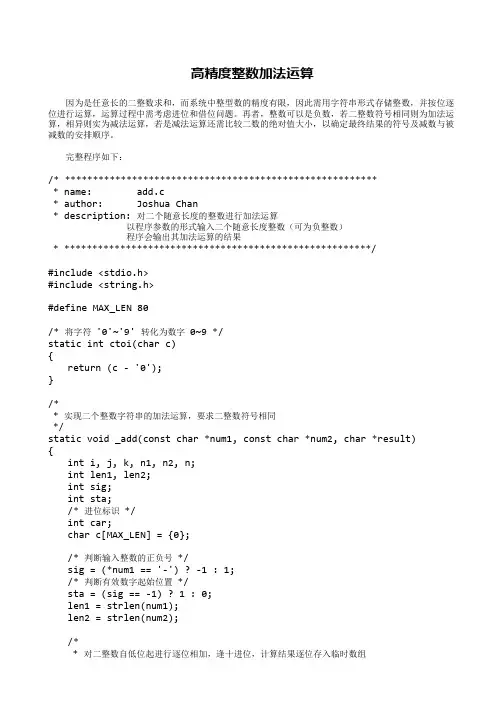

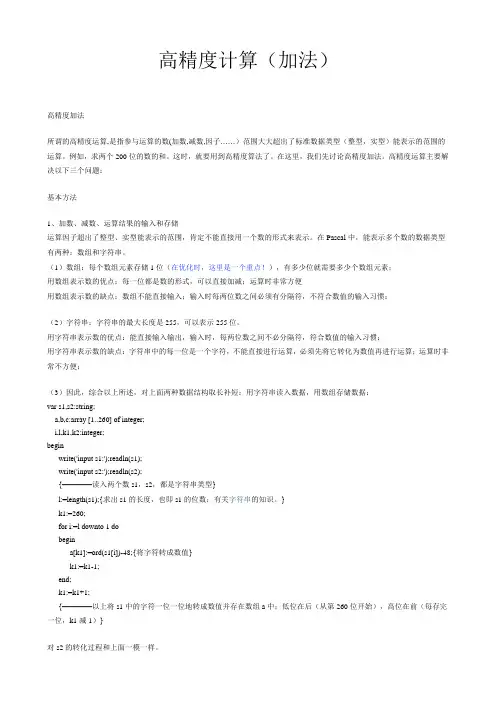
高精度计算(加法)高精度加法所谓的高精度运算,是指参与运算的数(加数,减数,因子……)范围大大超出了标准数据类型(整型,实型)能表示的范围的运算。
例如,求两个200位的数的和。
这时,就要用到高精度算法了。
在这里,我们先讨论高精度加法。
高精度运算主要解决以下三个问题:基本方法1、加数、减数、运算结果的输入和存储运算因子超出了整型、实型能表示的范围,肯定不能直接用一个数的形式来表示。
在Pascal中,能表示多个数的数据类型有两种:数组和字符串。
(1)数组:每个数组元素存储1位(在优化时,这里是一个重点!),有多少位就需要多少个数组元素;用数组表示数的优点:每一位都是数的形式,可以直接加减;运算时非常方便用数组表示数的缺点:数组不能直接输入;输入时每两位数之间必须有分隔符,不符合数值的输入习惯;(2)字符串:字符串的最大长度是255,可以表示255位。
用字符串表示数的优点:能直接输入输出,输入时,每两位数之间不必分隔符,符合数值的输入习惯;用字符串表示数的缺点:字符串中的每一位是一个字符,不能直接进行运算,必须先将它转化为数值再进行运算;运算时非常不方便;(3)因此,综合以上所述,对上面两种数据结构取长补短:用字符串读入数据,用数组存储数据:var s1,s2:string;a,b,c:array [1..260] of integer;i,l,k1,k2:integer;beginwrite('input s1:');readln(s1);write('input s2:');readln(s2);{————读入两个数s1,s2,都是字符串类型}l:=length(s1);{求出s1的长度,也即s1的位数;有关字符串的知识。
}k1:=260;for i:=l downto 1 dobegina[k1]:=ord(s1[i])-48;{将字符转成数值}k1:=k1-1;end;k1:=k1+1;{————以上将s1中的字符一位一位地转成数值并存在数组a中;低位在后(从第260位开始),高位在前(每存完一位,k1减1)}对s2的转化过程和上面一模一样。
【C语言】编写C代码求100的阶乘进行高精度计算在计算机科学领域中,高精度计算是指对于超过所用数据类型所能表示的数值进行计算,常用于科学计算、密码学等领域。
而本文将介绍如何使用C语言进行高精度计算,并以求100的阶乘为例进行示范。
一、数据结构定义首先,我们需要定义一种能够存储大整数的数据结构。
在本文中,我们使用结构体来定义这个数据类型,它包含一个整数数组(用于存储每位数字),以及一个整数表示该数的位数。
typedef struct {int len; // 数字的位数int num[MAX]; // 数字数组}BigInt;其中,MAX为定义的数组最大长度。
二、初始化函数接着,我们需要定义一个函数来初始化这个数据类型。
由于每个数据类型都有一个初始值,我们可以将其初始化为0,其具体实现如下:void init(BigInt *p){p->num[0] = 0;p->len = 1;memset(p->num, 0, sizeof(p->num));}三、高精度乘法接下来,我们需要实现高精度乘法。
具体实现方法是模仿手算的乘法过程,从右往左遍历两个数的每一位,然后计算出各位上的乘积、进位和当前位的结果。
void mul(BigInt *p, int n){int i, t = 0;for (i = 0; i < p->len; ++i){t += n * p->num[i];p->num[i] = t % 10;t /= 10;}while (t > 0){p->num[p->len++] = t % 10;t /= 10;}}四、求阶乘有了高精度乘法之后,我们就可以使用循环来对100进行阶乘运算。
具体实现如下:void factorial(BigInt *p, int n){int i;for (i = 2; i <= n; ++i)mul(p, i);}五、完整代码#include <stdio.h>#include <stdlib.h>#include <string.h>#define MAX 1000typedef struct {int len;int num[MAX];}BigInt;void init(BigInt *p){p->num[0] = 0;p->len = 1;memset(p->num, 0, sizeof(p->num)); }void mul(BigInt *p, int n){int i, t = 0;for (i = 0; i < p->len; ++i){t += n * p->num[i];p->num[i] = t % 10;t /= 10;}while (t > 0){p->num[p->len++] = t % 10;t /= 10;}}void factorial(BigInt *p, int n){int i;for (i = 2; i <= n; ++i)mul(p, i);}void print(BigInt *p){int i;for (i = p->len - 1; i >= 0; --i)printf("%d", p->num[i]);printf("\n");}int main(){BigInt res;init(&res);factorial(&res, 100);printf("100! = ");print(&res);return 0;}六、总结高精度计算作为计算机科学中的重要应用之一,为许多计算机算法和应用提供了强大的支持。
C语言中double的精度问题1.概述C语言中的double类型在处理浮点数时存在精度问题,这是因为计算机采用二进制来表示浮点数,而大部分小数无法以有限的二进制表示。
这导致在对小数进行计算时,可能会出现精度损失或不准确的结果。
本文将从浮点数表示、精度损失原因、解决方法等方面来探讨C语言中double的精度问题。
2.浮点数表示在计算机中,浮点数通常采用IEEE 754标准来表示。
这种标准基本上将浮点数表示为科学计数法的形式,包括符号位、指数位和尾数位。
这种表示方法在大多数情况下能够满足计算需求,但由于二进制表示受限于计算机存储空间,仍然存在一定的精度问题。
3.精度损失原因C语言中double类型通常使用64位来表示浮点数,其中52位用于尾数,11位用于指数,1位用于符号。
虽然这种表示方法相对较为精确,但对于一些特定的小数,依然可能会出现精度损失。
对于无法用有限小数表示的小数,计算机只能进行近似表示,从而导致精度损失。
4.解决方法针对C语言中double的精度问题,可以采用以下解决方法:4.1. 使用更高精度的数据类型,比如long double。
这种方法能够提高浮点数的表示精度,但对于大部分应用来说并不需要如此高的精度。
4.2. 尽量避免浮点数的比较操作,可以通过设定一个误差范围来进行比较。
因为浮点数计算结果的精度是有限的,直接比较可能会导致错误的结果。
可以定义一个非常小的误差范围,在比较时检查两个浮点数的差值是否在这个范围之内。
4.3. 对于一些特定的计算,可以采用整数运算或其他更精确的表示方法来避免浮点数的精度问题。
5.个人观点在实际编程中,尤其是需要高精度计算的情况下,C语言中double的精度问题可能会成为一个非常重要的考虑因素。
我认为在编写代码时,应该充分了解浮点数在计算机中的表示方式和精度限制,从而采用适当的措施来避免精度问题给程序带来不确定性。
对于涉及大量浮点数计算的程序,也建议进行充分的测试和验证,以确保计算结果的准确性。
c语言中double的用法举例C语言是一种广泛使用的编程语言,它支持多种数据类型,其中包括double类型。
double类型是一种浮点数类型,可以表示比float 类型更大范围的实数。
在C语言中,double类型通常用于存储需要高精度计算的数据,如科学计算、金融计算等领域。
本文将详细介绍C语言中double类型的用法,并给出一些实例。
一、double类型的定义和初始化在C语言中,double类型的定义和初始化与其他数据类型类似。
可以使用关键字double来定义一个double类型的变量,例如:double x;这个语句定义了一个名为x的double类型变量。
如果需要初始化这个变量,可以使用以下语句:double x = 3.14;这个语句将x初始化为一个值为3.14的double类型变量。
需要注意的是,double类型的数值在内存中通常占用8个字节,因此需要充分利用内存空间。
二、double类型的运算在C语言中,double类型的运算与其他数据类型类似。
可以使用加减乘除等运算符进行运算,例如:double x = 3.14;double y = 2.71;double z = x + y;这个语句将z初始化为x和y的和,即5.85。
需要注意的是,在运算时可能会出现精度损失的情况,因此需要谨慎处理。
三、double类型的转换在C语言中,double类型可以和其他数据类型进行转换。
例如,将一个整数转换为double类型可以使用以下语句:int x = 3;double y = (double)x;这个语句将x转换为double类型,并将结果赋值给变量y。
需要注意的是,在进行转换时可能会出现精度损失的情况,因此需要谨慎处理。
四、double类型的输入和输出在C语言中,可以使用scanf和printf等函数进行double类型的输入和输出。
例如,以下语句将从标准输入中读取一个double类型的数值,并将其赋值给变量x:double x;scanf('%lf', &x);需要注意的是,%lf是scanf中用于读取double类型数值的格式控制符。
c float16运算主题:浮点数运算中的float16引言:在计算机科学中,浮点数是一种用于近似表示实数的数据类型。
它们通常使用二进制表示,并由一个符号位、一个指数位和一个尾数位组成。
然而,不同的浮点数类型在存储精度和计算效率之间存在不同的权衡。
在本文中,我们将专注于一种浮点数类型——float16,并探讨它在计算过程中的特点和应用。
1. 什么是float16?Float16,也称为半精度浮点数,是一种用于表示实数的16位浮点数类型。
它由1个符号位、5个指数位和10个尾数位组成,可以表示的范围和精度相对于更高精度的浮点数类型(如float32或float64)来说较为有限。
2. float16的使用场景尽管float16的表示范围较小,但在某些场景下,它仍然具有广泛的应用。
一般来说,float16适用于计算资源有限且对精度要求相对较低的应用场景。
下面是一些常见的使用场景:- 机器学习模型推理:在模型推理过程中,通常不需要高精度的计算。
使用float16可以显著减少计算资源的消耗,提高推理速度。
- 游戏开发:在游戏中,许多图形和物理计算可以通过float16进行近似计算,从而减少计算负担,提高游戏性能。
- 移动端应用:移动设备的计算资源相对有限,float16可以在提供合理计算精度的同时减少能耗。
3. float16与其他浮点数类型的区别与其他浮点数类型相比,float16具有一些独特的特点和限制:- 较小尺寸:相比于float32和float64,float16需要更少的存储空间,这对于存储和传输大量浮点数数据是非常有利的。
- 有限的表示范围:float16可以表示的正负数范围较小,约为-65504到+65504之间。
- 相对较低的精度:float16的尾数位数较少,因此它的相对精度要低于float32和float64类型。
4. float16运算的实现方式在它的16位存储空间下,float16支持一系列基本运算操作,例如加法、减法、乘法和除法。
gmp大数库静态编译【原创实用版】目录1.GMP 大数库的概述2.静态编译的定义与作用3.GMP 大数库与静态编译的关联4.GMP 大数库的编译方法5.静态编译的优势与不足6.总结正文1.GMP 大数库的概述GMP(GNU Multiple Precision Arithmetic Library) 是一个用于高精度计算的 C 库,提供了大数运算和各种数学函数。
GMP 大数库可以处理任意精度的整数、分数、有理数和浮点数,其精度可以达到几十亿位甚至更多。
GMP 大数库广泛应用于数学软件、密码学、计算机图形学等领域。
2.静态编译的定义与作用静态编译是一种编译方式,指在编译时将所有需要的库文件和函数都链接到目标代码中,形成一个独立的可执行文件。
静态编译的优点是可以避免在运行时寻找和加载库文件的麻烦,缺点是可执行文件会较大,且不同平台下的可执行文件可能需要重新编译。
3.GMP 大数库与静态编译的关联由于 GMP 大数库提供了大量的数学运算函数,因此在编译时可能需要将 GMP 库文件链接到目标代码中,以实现高精度计算功能。
而静态编译可以方便地将 GMP 库文件链接到目标代码中,形成一个独立的可执行文件。
4.GMP 大数库的编译方法要使用 GMP 大数库进行静态编译,需要先安装 GMP 库,并在编译时使用适当的编译选项将 GMP 库文件链接到目标代码中。
具体的编译方法取决于使用的编程语言和编译器。
例如,在 C 语言中,可以使用`-lgmp`选项将 GMP 库链接到目标代码中,而在 Python 中,可以使用`numpy`库来方便地调用 GMP 库函数。
5.静态编译的优势与不足静态编译的优势在于可以避免在运行时寻找和加载库文件的麻烦,提高程序的可移植性和稳定性。
此外,静态编译可以产生只读的可执行文件,有利于保护知识产权。
然而,静态编译的不足在于可执行文件会较大,且不同平台下的可执行文件可能需要重新编译。
6.总结GMP 大数库是一个功能强大的数学库,可以方便地处理高精度计算问题。
c语言计算结果保留两位小数在C语言中,我们通常需要进行数学计算来完成各种任务,有时候我们需要保留计算结果的小数位数,这就需要用到浮点数类型和一些格式控制符,并按照具体要求对其进行精度控制。
下面,将围绕C语言计算结果保留两位小数这个主题做详细的讲解。
一、浮点数类型C语言支持不同类型的变量,在数学计算中,我们通常会使用浮点数类型(float和double)来进行处理。
float类型用于存储单精度实数,它占四个字节,可以表示小数点后6位数,而double类型用于存储双精度实数,它占八个字节,可以表示小数点后15位数。
一般而言,当需要进行高精度的计算时,double类型会更为适用。
二、精度控制由于浮点数类型是基于二进制的,所以在进行计算时难免会出现精度误差。
为了更好地控制计算结果的精度,在输出浮点数时,需要采用一些格式控制符来指定输出的位数。
如下所示:- %.nf:指定输出n位小数,如果实际位数不足n位,则用0来补齐。
- %.nnf:指定输出总共n位,其中小数部分为f。
如果总位数小于n,则在左边补齐空格。
- %g:这个格式控制符是比较常用的,它可以自动决定应该采用%f还是%e来输出实数。
通常情况下,%g控制符在显示实数时也能保证精度。
不过,我们可以通过在控制符后面加上小数位数来指定精度,例如%.2g。
三、实例演示下面我们通过一个实例演示在C语言中如何计算结果并保留两位小数。
以计算圆的面积为例,假如给定圆的半径为r,则可以使用下面的公式计算:are a = π * r * r其中,π为圆周率,我们可以使用3.14来近似表示。
示例代码如下:```c#include <stdio.h>#define PI 3.14int main(){float r;double area;printf("请输入圆的半径:");scanf("%f", &r);area = PI * r * r;printf("圆的面积为:%.2f\n", area);return 0;}```在这个例子中,我们先通过输入函数scanf()获取圆的半径r,然后根据给定公式计算出圆的面积。